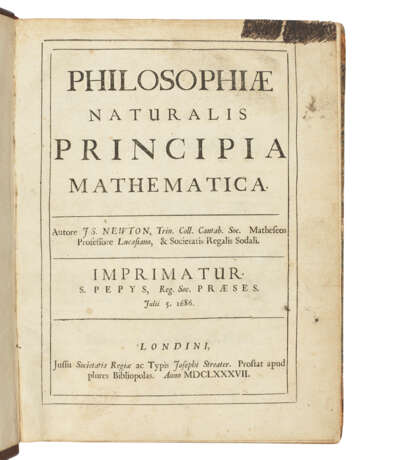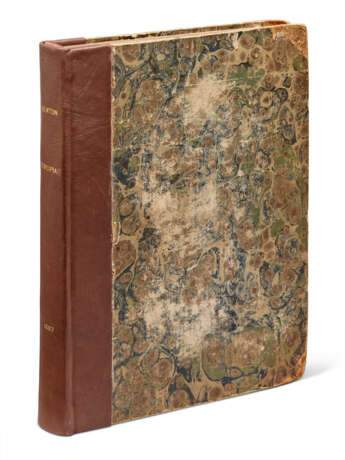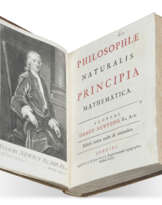ID 1450376
Los 104 | NEWTON, Sir Isaac (1642-1727)
Schätzwert
£ 80 000 – 120 000
Philosophiae naturalis principia mathematica. Edited by Edmond Halley (1656-1743). London: Joseph Streater for the Royal Society [at the expense of Edmond Halley], to be sold by various booksellers, 1687
First edition of ‘the greatest work in the history of science’ (PMM), from the library of the mathematician Paul Stäckel. The Principia elucidates the principle of universal gravitation and lays the foundations of classical mechanics, expressed by Newton in his three laws of motion. Building upon the work of Galileo, Kepler and Copernicus, Newton applies mathematical principles to explain the phenomenologically revealed world: Book one treats the movement of bodies without resistance; Book two, the movement of bodies in a resisting medium; and Book Three is concerned particularly with the consequences of gravitational attraction in astronomy. ‘For the first time a single mathematical law could explain the motion of objects on earth as well as the phenomena of the heavens... It was this grand conception that produced a general revolution in human thought, equaled perhaps only by that following Darwin's Origin of Species’ (PMM). Principia marked the culmination of the Scientific Revolution and the order Newton proposed for the universe remained unchallenged for over two centuries, until the development of Einstein's theory of relativity and Planck's quantum theory. Newtonian physics is still used extensively today, especially in engineering applications; his principles and methods provide an accurate and useful framework for the solution of many scientific problems.
The publication of the Principia owed much to Edmond Halley, who used frequently to boast that he had been ‘the Ulysses who produced this Achilles’. Following a discussion on orbital dynamics between Newton and Halley in 1684, the former was inspired to produce the nine-page tract De motu (Concerning motion), in which he sketched an idea virtually identical to that which appears in the Principia. Halley asked Newton to write more for the Royal Society to publish and for the following two and a half years Newton devoted himself solely to this project: closeted away from society, he pursued a problem which kept expanding in every direction and revealing new facets. Halley received the complete manuscript for the book in April 1687 and he himself saw the work through the press, even bearing the cost of printing, since the Royal Society’s funds had been depleted. The printing history of the Principia is well documented, and two issues are distinguished, based on the two states of the title-page: one with a 2-line imprint, as here, and one with a 3-line imprint naming the bookseller Samuel Smith, respectively denoting domestic or overseas distribution. The present copy belongs to the issue for distribution in Britain (two-line imprint), traditionally designated the first; Halley and Newton sold it through a number of unnamed booksellers. The other, smaller, issue was largely turned over to Samuel Smith for distribution on the continent and required a cancel-title (three-line imprint). The edition was divided between two compositors working concurrently, one setting the first two books, the other setting the third. W. Todd has identified a number of stop-press corrections, but they cannot be related to either issue.
Babson 10; Dibner 11; Grolier/Horblit 78 (‘the most influential scientific publication of the seventeenth century’); PMM 161; A.N.L. Munby, ‘The two title-pages of Newton's Principia’ in Notes and Records of the Royal Society 10 (1952); W. Todd's bibliography in Koyré & Cohen's ed. of Newton's Principia II, 851-3; Norman 1586 (3-line imprint title); PMM 161; Wallis 6; Wing N-1048.
Quarto (241 x 185mm). Numerous woodcut diagrams. Title in first state with 2-line imprint, uncancelled; P4 cancel correcting orientation of the diagram on verso, errata at end (folding engraving of cometary orbit lacking and supplied in printed facsimile, without final blank Ooo4 as usual, minor soiling to title page, browning more pronounced in *** and 3F and margins of P4 and 2A3, bottom corner of R4 chipped affecting a couple of letters, small losses to margins of K1, Z3, 2B4, 2C3, 2G1 and 2G4, small tear by gutter of 2Z2). 18th-century half calf over marbled boards (rebacked, edges and boards rubbed, corners bumped). Provenance: erased ownership inscription on title page – Paul Stäckel (1862-1919, German mathematician; bookplate on endleaf) – 20th-century annotations in English in margins of B and E, dated in pencil on verso of title page.
| Künstler: | Isaac Newton (1643 - 1727) |
|---|---|
| Herkunftsort: | England, Nordeuropa, Europa, Vereinigtes Königreich |
| Kategorie des Auktionshauses: | Medizin und Wissenschaft, Bücher und Handschriften, Gedruckte Bücher |
| Künstler: | Isaac Newton (1643 - 1727) |
|---|---|
| Herkunftsort: | England, Nordeuropa, Europa, Vereinigtes Königreich |
| Kategorie des Auktionshauses: | Medizin und Wissenschaft, Bücher und Handschriften, Gedruckte Bücher |
| Adresse der Versteigerung |
CHRISTIE'S 8 King Street, St. James's SW1Y 6QT London Vereinigtes Königreich | |
|---|---|---|
| Vorschau |
| |
| Telefon | +44 (0)20 7839 9060 | |
| Aufgeld | see on Website | |
| Nutzungsbedingungen | Nutzungsbedingungen |





![[NEWTON, Isaac (1642-1727)]](/assets/image/picture_4036009/5c8e6/3e601c7a9444e346ef4136ceaf96156f1720562400jpg__fix_162_205.jpeg)






![[NEWTON, Isaac, Sir (1642-1727)]](/assets/image/picture_5109616/99751/5d28e844288dbc71121959c3b0b354f51765321200jpg__fix_162_205.jpeg)

